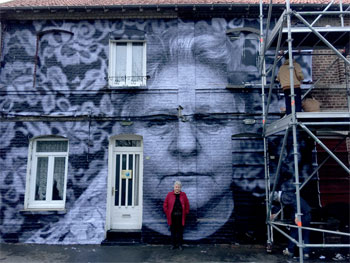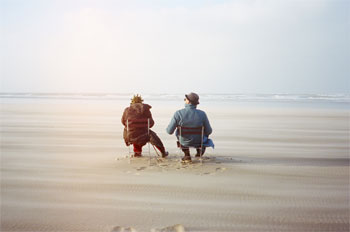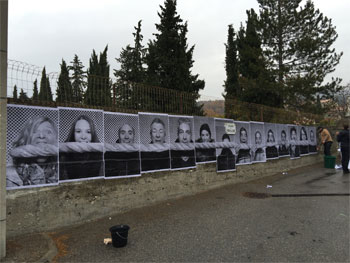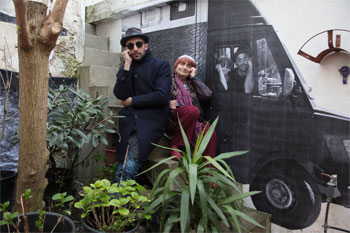Faces Places Agnes Varda and Jr Interview

Visages Villages (Faces Places)
Cast: Jean-Paul Beaujon, Amaury Bossy, Yves Boulen
Director: Agnès Varda
Genre: Documentary
Rated: G
Running Time: 89 minutes
Synopsis: Agnès Varda, whose unique cinematic vision since the 1950s has earned her a loyal following of enthusiastic cinephiles around the world, and the iconic photographer/muralist JR, boasting over a million followers on Instagram, have more in common than one might imagine. Both share a lifelong passion for images and how they are created, displayed, and shared. Agnès chose to explore her passion through cinema and documentary, JR through his emotionally arresting open-air photo installations.
When JR, a long-time fan, went to meet Agnès at her home on Rue Daguerre, they both knew immediately they wanted to work together. Faces Places documents their heart-warming journey through rural France and the unlikely, tender friendship they formed along the way.
Faces Places
Release Date: January 25th, 2018
Conversation between Agnès Varda and JR based on an interview by Olivier Pere on January 31st, 2017.
Question: How did this film come about? Why did you want to make this film together?
JR: Let's start at the beginning.
JR: I made the first step. I went to see Agnes, at Rue Daguerre. I photographed the legendary façade of her place, where she lived a hundred years. And I took photos of her with a cat.
Agnès Varda: Your grandma's a hundred, not me. Not yet. The next day, I went to see him at his studio. I took portraits of him and quickly realised he wasn't going to remove his sunglasses.
JR: We met again the next day and the day after for tea.
Agnès Varda: I immediately sensed we'd do something together.
JR: At first we talked about a short film…
Agnès Varda: … a documentary. It seemed clear that your habit of pasting big pictures of people up on walls, empowering them through size, and my habit of listening to them and spotlighting what they say, would lead to something.
JR: And we wanted to hit the road together. Neither Agnes nor I had ever co-directed a film before.
 Question: Why did you choose to focus primarily on people in the French countryside?
Question: Why did you choose to focus primarily on people in the French countryside?JR: Agnes wanted to get me out of cities.
Agnès Varda: That's right, because you're truly an urban artist. And I love the country. We quickly hit on the idea of villages. That's where we'd meet people, and that's what happened. We took off in your incredible photo truck. The truck's the actor in the film, always putting on a show.
JR: I've used that truck for years, for lots of projects.
Agnès Varda: Yes, but this was our project and we set off in it together. At any rate, we had fun driving around rural France in that truck. Going here and there.
Question: Was there a plan at least, an itinerary? How do you develop a film that's essentially based on chance? On encounters? On discovery?
Agnès Varda: Sometimes one of us knew someone in a village or had a specific thing in mind. So we'd go check it out. As always in documentaries – and I've done lots of them – you have an idea, but before long, chance enters into play – who you meet and who you know – and suddenly things congeal to focus on a specific person or place. Actually, we embrace chance, we enlist it as an assistant!
JR: We engage life too, since the film's also the story of our encounter. We got to know each other on the road through the project and the amusing experience of working as a duo. I'm learning to understand Agnes a little better, what she sees and how she sees it, and she's also trying to understand my artistic process. We talk a lot and try out ideas. Then we envisioned a feature film.
Agnès Varda: That's when Rosalie took the reins to produce it.
JR: You said, 'let's do this".
Question: The film is a journey through France but also through memory, both personal and collective. Of workers, farmers and villagers.
JR: Wherever we are, we can tell pretty quickly whether we're going to make a connection.
Agnès Varda: One thing I like about you is how fast you work. As soon as we meet someone, you're already imagining what we could do with them. For instance, the postman in Bonnieux whom I knew and wanted you to meet because I like postmen. I like letters and stamps. You communicate essentially on the web and get 20,000 likes when you post an image and here you agreed to turn that postman into a village hero, in giant format.
JR: Three stories tall.
Agnès Varda: He was proud to be so big. From there we drove to Alpes-de-Haute-Provence.
JR: And someone told us about the factory near Chateau Arnoux.
Agnès Varda: I knew the guy from the local movie theatre, Jimmy. I'd presented Vagabond there. He showed us the factory.
JR: It's a little dangerous (an upper-tied Seveso site). We were curious and went to check it out. We met people and came up with some ideas there.
Agnès Varda: Industrial sites are beautiful. And the people who work there are good-hearted.
JR: They played along with us for a group photo. Some of the other places I assumed I was introducing you to, but it turned out you'd already been there years before. I was inspired by photos you took a long time ago. The collages in the film are the fruit of our collaboration.
Agnès Varda: Often what you paste up are my photos.
JR: That's true.
Agnès Varda: Like the big goat with horns. I took that picture when we were location scouting.
JR: We spent a lot of time with Patricia, the woman who kept her goats' horns instead of burning them off at birth like everyone else.
Agnès Varda: People are intense when it comes to their work and words. That woman grew very impassioned about goats and their horns, her conviction was impressive.
JR: And in the North too we heard some powerful things.
Agnès Varda: The mines are all gone today, but we met a woman, Jeannine, who's the last inhabitant in a row of miners' houses. She talked about her father who was a miner, and the former miners shared some beautiful stories about a world we know little about. It was interesting to hear them talk with such fervor. We were touched by Jeannine.
JR: You delve deep when you interview people. I was captivated to see you lead those conversations.
Agnès Varda: You spoke to them a lot too.
JR: OIf course. I've always loved doing that in my projects, like I've always seen you do in your films, with your own special approach that's so gentle and delicate… and feminist too.
Agnès Varda: Ah, I am indeed a feminist!
 Question: Women are very present in the film. You show their importance in the agricultural milieu and the working class.
Question: Women are very present in the film. You show their importance in the agricultural milieu and the working class. Agnès Varda: Yes, JR and I both agreed it's important and makes sense to let women have their say.
JR: That was Agnes' idea. When I showed her all the photos of the dockworkers in Le Havre, she said 'Where are the women?" So I called the dockworkers back and asked, 'Could your wives come to the port?" They said, 'Listen, they never have, but maybe this is the chance." It was pretty crazy to have them discover the port through this project.
Agnès Varda: Three interesting women with something to say, it was great. I was pleased to see them in the spotlight, 'for once", as one of them said. The dockworkers helped out by putting huge containers at our disposal. We used them like Lego to build towers, make totems. You have to see it, words don't do justice. What an adventure!
JR: We should also mention the dockworkers were in the middle of one of their biggest strikes. I'm still amazed they gave art such a place of honor, regardless of what was going on.
Agnès Varda: It's the idea that art is for everyone. The dockworkers agreed to help us because they were keen to participate in an artistic project.
JR: One of the factory workers said, 'Art is meant to surprise us!" We disrupted them, but they accepted us. There were serious and complex events going on in France and around the world, yet we were committed to our project and the people we met understood that.
Agnès Varda: A modest project in a period of widespread chaos.
Question: And in fact, your film is soothing.
Agnès Varda: They also liked our good cheer and the way you'd tease me. We were intent on being ourselves and involving them in our project.
Question: You develop powerful relationships with the people you meet. You also remember the dead and pay homage to them during your travels; Nathalie Sarraute, Guy Bourdin, Cartier-Bresson.
Agnès Varda: Yes, I knew them. Evoking them means placing them back in the present. It's the result that is present. I passed Nathalie Sarraute's house by chance, and that made me happy, but what we were interested in is the local farmer down the stress who farms 2,000 acres on his own.
JR: Another place we filmed was an abandoned village. The place had a past, and we had our photo tracuk. We help a party with the locals. It's got a funny name: Pirou-Plage.
Agnès Varda: And that night there were hundreds of faces up on the walls. We left the next day. We learned since that the village has been demolished. Everything is changing.
JR: We don't work solidly; our days are specific.
Agnès Varda: That's what I've always loved with documentaries. You spend a few days with people, you become friends then you lose touch with them, just like the way you depict them with large ephemeral images that will vanish from the walls. We know these moments are magical. The moment of meeting people, the moment of filming, pasting and voila! I really love that.
JR: The moments don't last, yet remain engraved.
Question: How did the shoot take place?
Agnès Varda: We'd take one or two trips then stop, because I'm not strong enough anymore to shoot eight weeks in a row, standing out in the fields. We shot two to four days per month.
JR: I think it worked well. It allowed us to think things through, reflect and see where we were going. We started the editing. We'd talk for hours to figure out where to go and how. I've got a more -improvisational' side to me. 'Let's try, and see if it works." Agnes, on the other hand, thinks out the whole sequence and a few specific shots. That reinforced the dynamic of our co-direction.
Agnès Varda: There's also a gap of several generations between us. Actually we didn't think about that at all, even if you do climb stairs faster than I do. We were models for each other. That's how I felt because, by filming the way you work, the way you climb scaffolds, we also get a portrait of you and your work. And you were interested in me too, in my faltering eyes.
JR: Right, we tried to show what's happening to your eyes. I wanted to see for you, better than you who sees blurry... especially far away. I photographed your eyes very close and showed them from far away. And your toes too.
Agnès Varda: Oh yes, my toes. I got a chuckle out of your ideas. Your constant teasing, but also the way you invented images of our friendship. It's true, we share the desire to explore places and forms.
JR: I'd like to talk about something that seems important. Everyone we met taught us something. And vice versa.
Agnès Varda: When we tell the garage mechanic about the goats with no horns, he says 'Oh, that's amazing. I've learned something new. I'll tell people about it"
JR: From one person to another, from one idea to the next. Actually, the film's a collage.
 Question: The entire film's a collage. With JR pasting giant photos on the walls and Agnes' carrying out a cinematographic collage, with rhymes and visual riddles.
Question: The entire film's a collage. With JR pasting giant photos on the walls and Agnes' carrying out a cinematographic collage, with rhymes and visual riddles. Agnès Varda: I really like the idea that the editing process is a montage, a collage with plays on words and plays on images that take hold so we don't have to say 'chapter 1, chapter 2". Sometimes I would visualise the montage as a series of words that rhyme (in French): faces, places, collages, sharing…
Question: And shores. Tell us about the blockhouse, that bunker on the beach.
JR: I often go to Normandy to ride motorcycles on the beach and I discovered a spot where a German blockhouse from the war had fallen off the cliff and was sticking straight up in the middle of the beach. I mentioned it to Agnes but she didn't seem too interested. Then one day I told her the name of the village and it clicked. She went, 'Wait, I know Saint-Aubin-Sur-Met, I went there with Guy Bourdin back in the -50s." I took her there, and she took me to Guy Bourdin's house nearby. She showed me the photos she took of him back then. We walked together on the beach and said, 'Why not put him here?" The pasting was grueling because we had to go fast. The blockhouse is huge and the ide was coming in.
Agnès Varda: I'd taken that photo of Guy Bourdin sitting down with his legs out straight, but it was your idea to paste him titled, and turn the war bunker into a cradle nestling a young man. I was extremely moved by how the meaning of the photo was transformed, of what it briefly became. Then psshht, in came the tide and washed it all away.
Question: The experience of that particular photo at the end of that particular sequence strikes me as the perfect illustration of your project: how it came about, how it developed and how it disappeared.
JR: The film expresses that, along with our friendship that grew throughout these experiences. What's happening with your eyes made an impression on me. It upset me, and also became the subject of the film.
Agnès Varda: That's going a little too far, but it's true that 'eyes and gaze" are important in your work, and in the film. You see clearly, which helps my blurry eyes, and – paradoxically – your eyes are always hidden behind dark glasses. We surprise each other.
I especially hope we'll surprise viewers with our relationship and through the amazing personal stories we gathered. I'll never forget some of the thing people said.
Question: The end of the film was surprising to me.
Agnès Varda: It's a surprise we experienced, and one I don't wish to comment on.
JR: When we got on the train, I didn't know where Agnes was taking me. That was the game. Then we stopped playing and everything became real, an adventure. Then we looked at Lake Leman….
Agnès Varda: … with its clement waters (it's true), and that's where we leave the film.
Faces Places
Release Date: January 25th, 2018
MORE
- Mission: Impossible Fallout
- Glenn Close The Wife
- Allison Chhorn Stanley's Mouth Interview
- Benicio Del Toro Sicario: Day of the Soldado
- Dame Judi Dench Tea With The Dames
- Sandra Bullock Ocean's 8
- Chris Pratt Jurassic World: Fallen Kingdom
- Claudia Sangiorgi Dalimore and Michelle Grace...
- Rachel McAdams Disobedience Interview
- Sebastián Lelio and Alessandro Nivola...
- Perri Cummings Trench Interview



